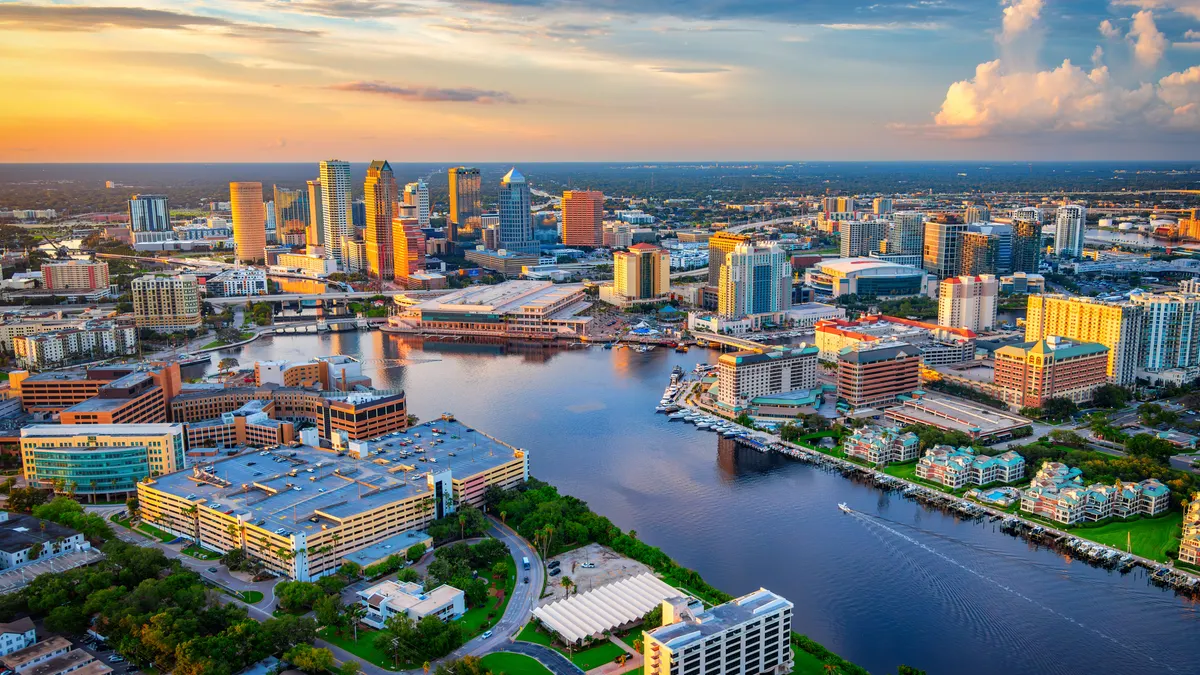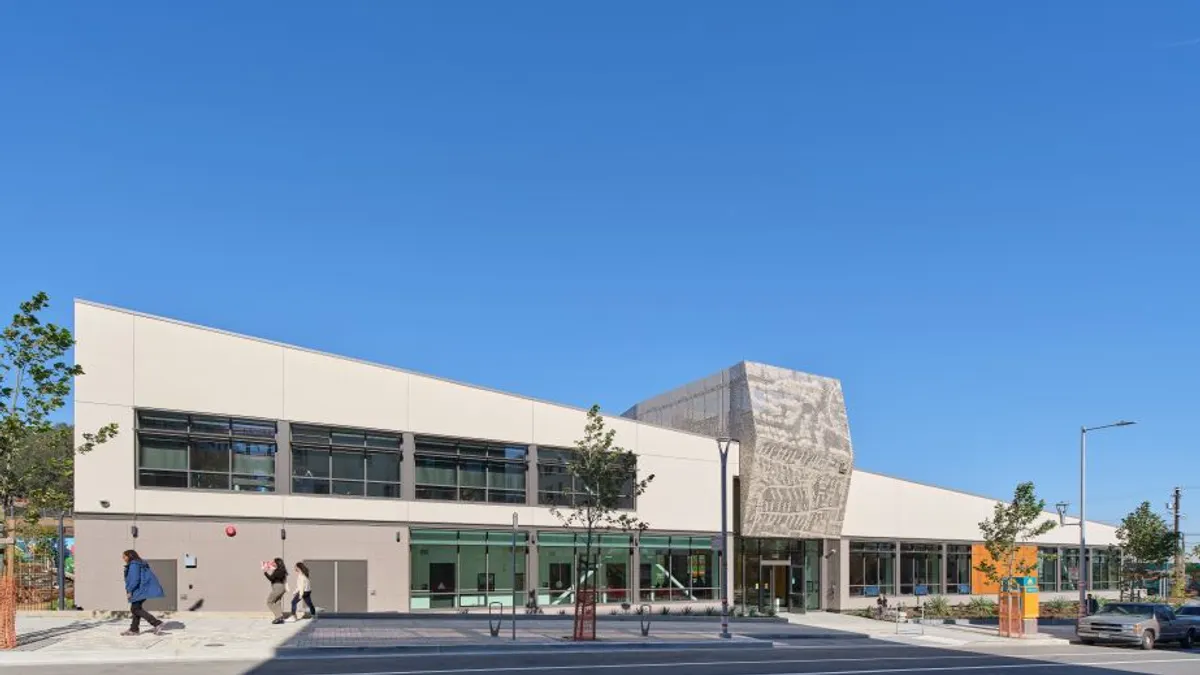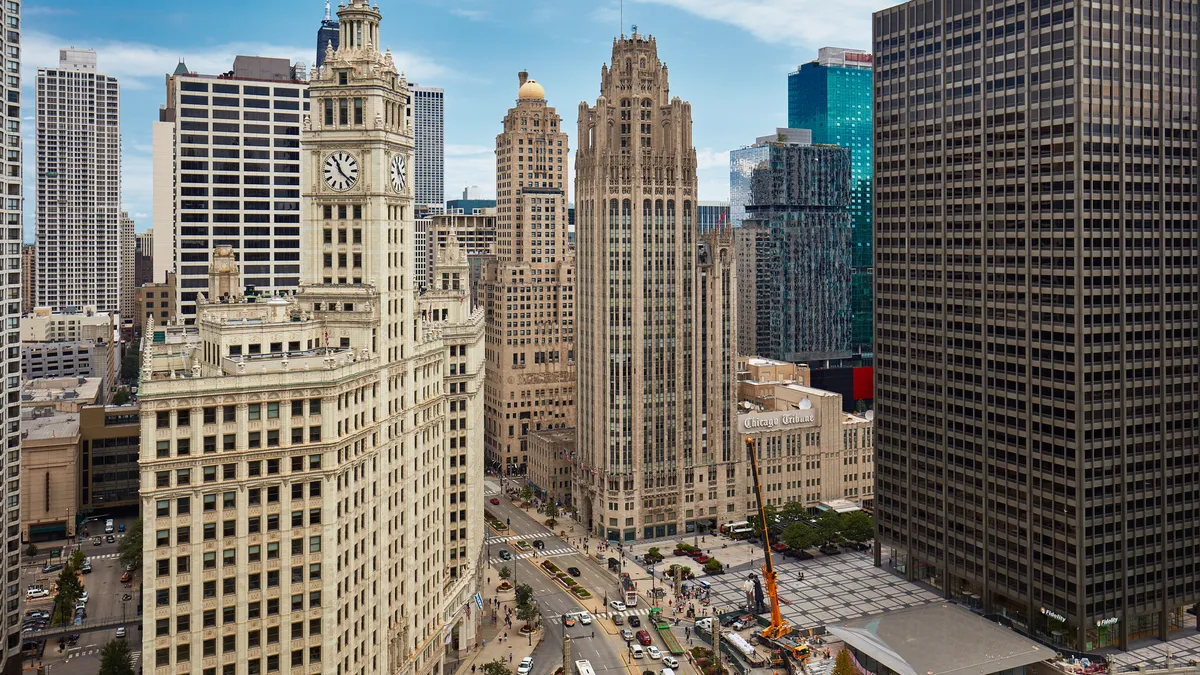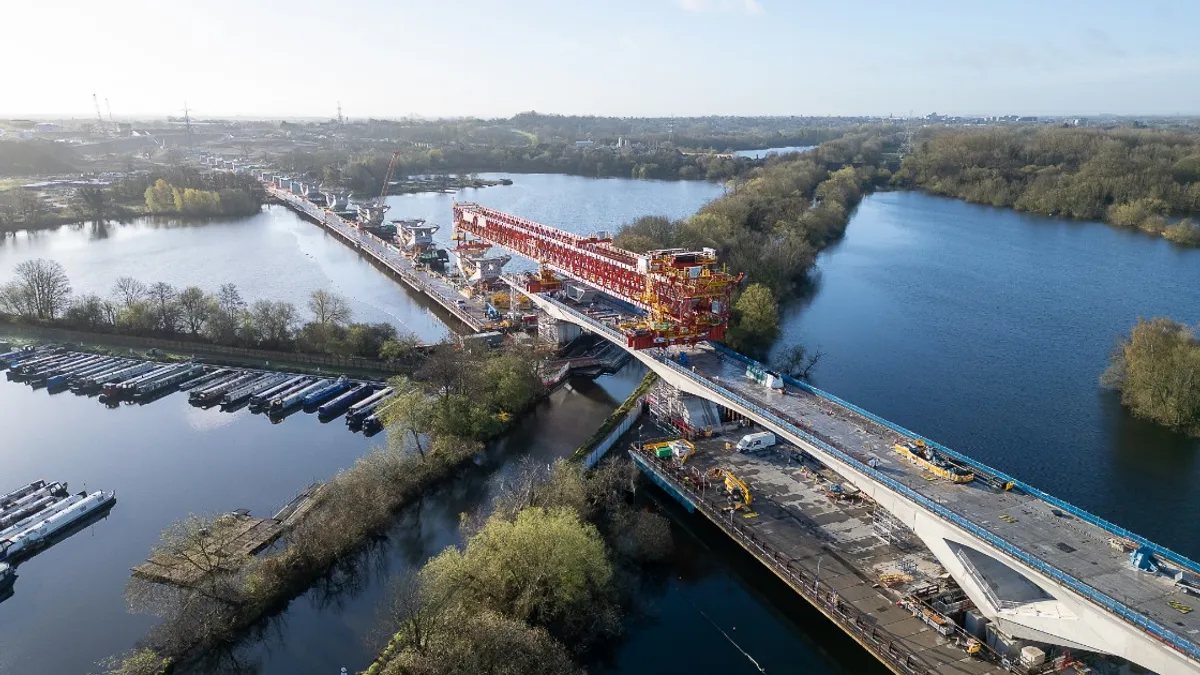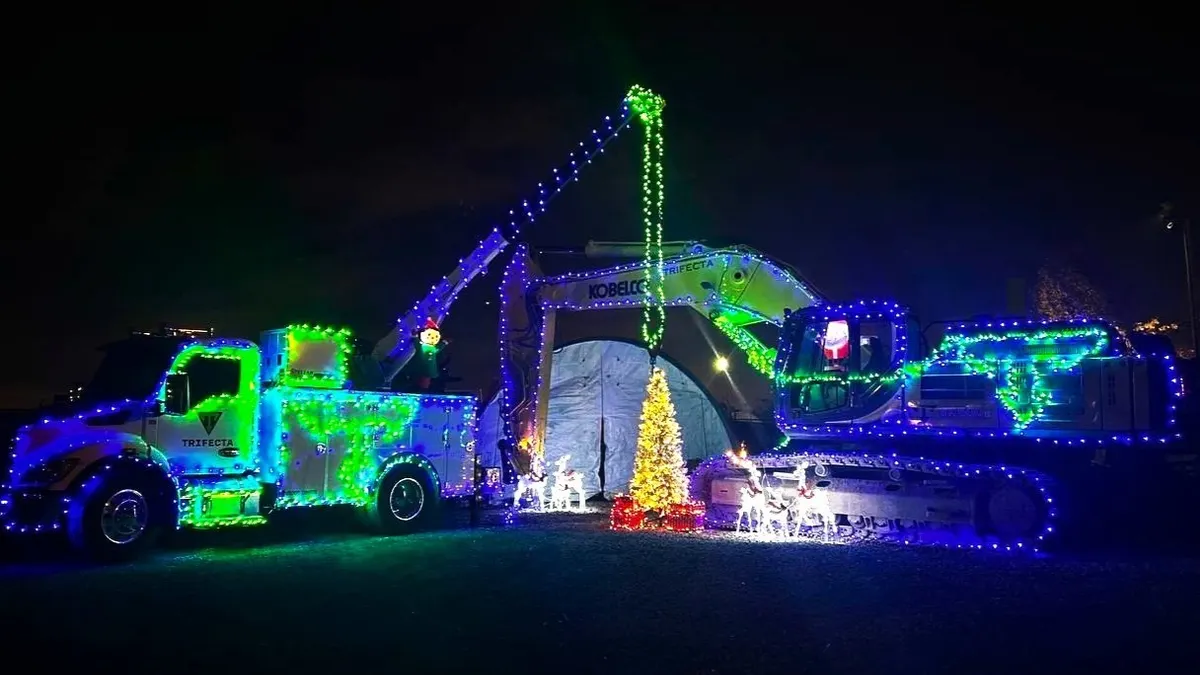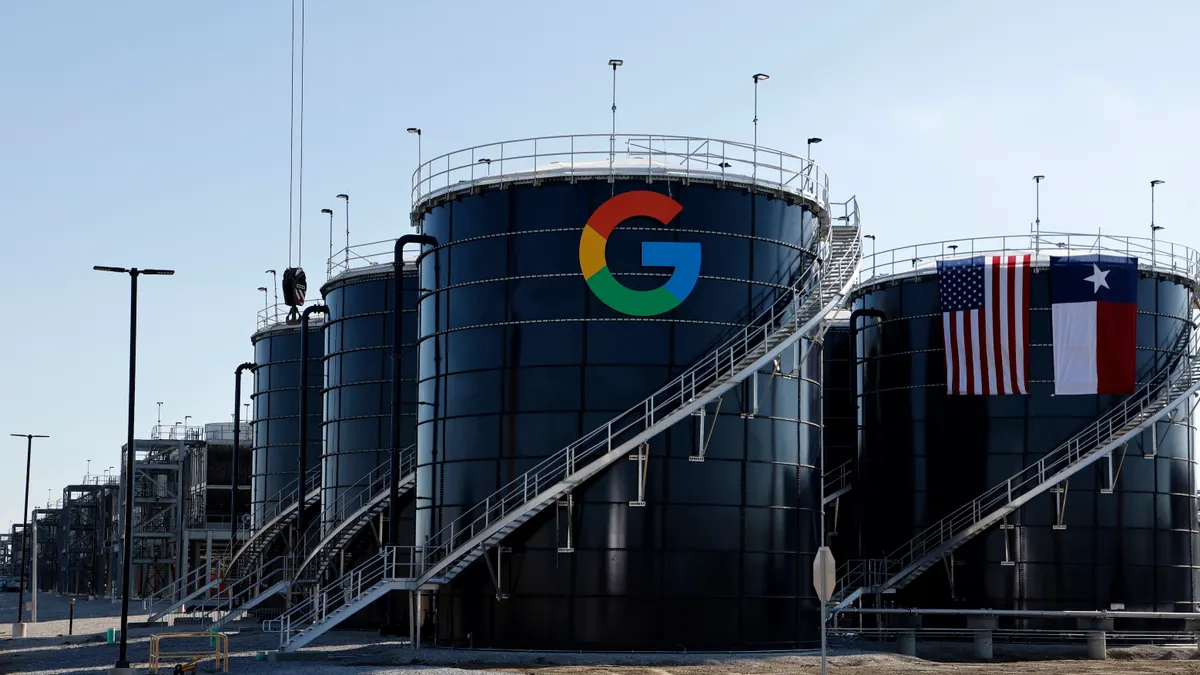Anticipation. Countdown. Liftoff. Celebration.
These are the iconic images of a rocket launch. But it’s the work on the ground that makes this feat possible.
NASA is looking beyond Earth’s orbit and has set its sights on deep space exploration, with Mars as the first target in the Space Launch System (SLS) program.
Three major SLS-related projects are currently underway at the Kennedy Space Center in Cape Canaveral, FL, under the Ground Systems Development & Operations (GSDO) program: updates to Launch Pad 39B, modernization of the Vehicle Assembly Building and construction of a new mobile launcher. These projects make up the bulk of GSDO's estimated costs to prepare for the first SLS launch — $2.8 billion.
Construction Dive got an inside look at each of these projects, which aim to make NASA’s Journey to Mars a reality.
NASA’s plans for space flight
The agency announced plans for the current SLS program in 2011, after the Space Shuttle program ended and the Constellation program — which ultimately intended to send a manned craft to Mars — was canceled amid budget concerns.
The SLS will send the attached Orion spacecraft, which completed a successful test launch in 2014, on deep space missions, starting with Mars but potentially leading to Jupiter and Saturn. The agency’s Journey to Mars initiative envisions a sustainable program in which NASA can launch consecutive missions for decades to come in a relatively cost-effective way.
NASA recently pushed back the date of the first SLS launch from late 2018 to early 2019 due to technical complications with multiple components of the program. Project engineers are preparing for the first unmanned test flight — Exploration Mission-1, or EM-1 — which will send the rocket into distant lunar retrograde orbit, followed by a manned flight as part of EM-2 by 2023.
The agency is studying whether it can add a crew to EM-1, but it hasn’t released its findings yet. Shifting to a manned flight could alter the launch date and mission trajectory.
The design of the SLS, which is in the super heavy-lift launch vehicle class of rockets, will evolve as NASA uses it for different missions and purposes. Block 1, the first SLS vehicle, will be 322 feet tall and weigh 5.75 million pounds when fueled. That first iteration will deliver a 77-ton lift capacity. It will be followed by Block 1B, which will deliver a 115-ton capacity, and Block 2, which will boast a 143-ton capacity.
The work necessary to bring those plans to life doesn’t come cheap — NASA has predicted that total investment in the SLS, Orion and GSDO projects will reach $23 billion by the end of fiscal year 2018.
Launch Pad 39B
GSDO engineers are working on several modernization projects at Pad 39B to convert it into a "clean pad" that is clear of most launch-specific structures and can support not only the SLS, but also other rocket launches. The revamp will allow rockets to spend less time on the pad before launch and potentially avoid delays, as the majority of work will be completed inside the VAB.
The pad has seen 53 shuttle missions since Apollo 10 marked its debut launch in 1969. While its long life has made the pad iconic, it has also created construction obstacles for work currently underway.
"We came across much more than we expected," said Nick Moss, pad element deputy project manager. That included "more rebar than you can imagine" and "a 50-year-old Coke can in the wall" found during pad modernization work.
The overall pad project includes the removal of fixed and rotating service structures that were built for space shuttle launches, as well as refurbishment of hydraulics, power and water systems.
Crews built three lightning protection masts — each 600 feet tall — to protect vehicles from strikes before launch. They also sandblasted a water tower that can hold 300,000 gallons of water and serves to suppress sound during takeoff. Fireproof bricks that have lined the trench for nearly 50 years were replaced with approximately 96,000 bricks, according to Moss.
Richard Smith, pad element technical manager, said he expects the Pad 39B project to be finished by late August. In early 2018, the under-construction mobile launcher will come to the pad for initial testing.
Vehicle Assembly Building and Crawler-transporter 2
The launch pad will be the final destination for the SLS on land, but the rocket has a few steps before it reaches that point. Sites across the U.S. are fabricating components that will be transported to the Kennedy Space Center’s massive Vehicle Assembly Building for the rocket.
The VAB was one of the largest buildings by volume when it opened in 1965. It stands at 525 feet tall and 518 feet wide, with a volume of 3,664,883 cubic meters.
Engineers are upgrading the VAB to prepare for the SLS and other heavy rockets, as previous vehicles were smaller and lighter. The building’s tallest section, the High Bay, features four corridors with 456-foot-tall doors — the largest doors in the world. The lower areas of the VAB will hold components of the rocket for future assembly.
A center transfer aisle in the VAB allows crews to bring large components and equipment into the building. It also contains five overhead cranes used to move the rocket components. Within the VAB, 20 platforms (10 on each side) can move vertically and horizontally to offer access points to the rocket.
Once engineers finish assembling the rocket, they will use a crawler to transport it and the mobile launcher along a 4.2-mile-long path from the VAB to Launch Pad 39B.
NASA is currently upgrading one of its two crawlers, the Crawler-transporter 2 (CT-2), to manage the heavier load required for the SLS vehicle.
The 50-year-old, 6.6-million-pound crawler can transport 18 million pounds. The trip from the VAB to the pad will take approximately eight hours.
Mobile launcher
The mobile launcher (ML) project has proven to be one of the most complex elements of the GSDO undertaking, as it required altering the design from the lighter vehicles involved with the Constellation program to the heavier SLS.
Hensel Phelps completed the first phase of the ML in 2010, which included construction of the basic structure and facility support systems. The project’s second phase involved gutting the project after the cancelation of Constellation. NASA then selected Rockledge, FL–based JP Donovan Construction to take on the ML’s third phase.
Subcontractors working under prime contractor JP Donovan include Bragg Companies, Core Electric, MDI and MJW.
Before the crawler brings the rocket to the launch pad, Orion and SLS will be attached to the mobile launcher through umbilical connections, which provide crew access to the rocket as well as power, communications, fuel and coolant.
The ML, including the base, stands 380 feet tall and weighs 10.5 million pounds. It also includes two bathrooms — one in the base and one higher in the main structure, which astronauts can use before launch.
ML Construction Project Manager Krista Shaffer said the team initially aimed to complete the current phase by June, but they have since added scope, such as the umbilicals, to the project, extending the schedule.
Shaffer said additional delays resulted from design issues, as "they had to change so much" due to the switch from the Constellation program to the SLS.
The ML’s future is still up in the air, as NASA is deciding whether it will modify the structure for EM-2 — which could require adding 60 feet atop the current ML — or build a new launcher for future missions.
Building for a new era of space exploration
The bevy of work currently underway at the Kennedy Space Center seeks to not only prepare the site for the SLS, but also to make it available to private companies looking to explore space travel, such as SpaceX, Boeing and Blue Origin, among others.
As consistent federal funding for NASA remains uncertain, the agency is utilizing the technology and capabilities of the Kennedy Space Center to become "a multi-user space port," said Matthew Miller, project/program coordinator with NASA’s Communication Office at the Kennedy Space Center.
But within NASA, all eyes are on the SLS, as the agency aims to go beyond current limits and spark new interest in space exploration.






